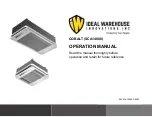
7
ACCESSORY USAGE GUIDELINE
ACCESSORY
REQUIRED FOR LOW---AMBI-
ENT COOLING APPLICATIONS
(Below 55
°
F/12.8
_
C)
REQUIRED FOR LONG
LINE APPLICATIONS*
REQUIRED FOR
SEA COAST
APPLICATIONS
(Within 2 miles/3.22 km)
Ball Bearing Fan Motor
Yes
{
No
No
Compressor Start Assist Capacitor and Relay
Yes
Yes
No
Crankcase Heater
Yes
Yes
No
Evaporator Freeze Thermostat
Yes
No
No
Hard Shut---Off TXV
Yes
Yes
Yes
Liquid Line Solenoid Valve
No
No
No
Motor Master
®
Control or
Low---ambient Pressure Switch
Yes
No
No
Support Feet
Recommended
No
Recommended
Winter Start Control
Yes #
No
No
*
Required for Low---Ambient Controller (full modulation feature) MotorMaster
r
Control.
{
Required for Low---Ambient Controller (full modulation feature) MotorMaster
r
Control.
# Required if Low Pressure Switch is factory or field installed.
Accessory Description and Usage (Listed Alphabetically)
1. Ball--Bearing Fan Motor
A fan motor with ball bearings which permits speed reduction
while maintaining bearing lubrication.
Usage Guideline:
Required on all units when MotorMaster
r
is used.
2. Compressor Start Assist -- Capacitor and Relay
Start capacitor and relay gives a ”hard” boost to compressor
motor at each start up.
Usage Guideline:
Required for reciprocating compressors in the
following applications:
Long line
Low ambient cooling
Hard shut off expansion valve on indoor coil
Liquid line solenoid on indoor coil
Required for single--phase scroll compressors in the
following applications:
Long line
Low ambient cooling
Suggested for all compressors in areas with a history of
low voltage problems.
3. Compressor Start Assist — PTC Type
Solid state electrical device which gives a ”soft” boost to the
compressor at each start--up.
Usage Guideline:
Suggested in installations with marginal power supply.
4. Crankcase Heater
An electric resistance heater which mounts to the base of the
compressor to keep the lubricant warm during off cycles.
Improves compressor lubrication on restart and minimizes the
chance of liquid slugging.
Usage Guideline:
Required in low ambient cooling applications.
Required in long line applications.
Suggested in all commercial applications.
5. Cycle Protector
The cycle protector is designed to prevent compressor short
cycling. This control provides an approximate 5--minute delay
after power to the compressor has been interrupted for any
reason, including power outage, protector control trip, thermostat
jiggling, or normal cycling.
6. Evaporator Freeze Thermostat
An SPST temperature--actuated switch that stops unit operation
when evaporator reaches freeze--up conditions.
Usage Guideline:
Required when low ambient kit has been added.
7. Low--Ambient Pressure Switch Kit
A long life pressure switch which is mounted to outdoor unit
service valve. It is designed to cycle the outdoor fan motor in
order to maintain head pressure within normal operating limits
(approximately 100 psig to 225 psig). The control will maintain
working head pressure at low--ambient temperatures down to 0
_
F
(--18
_
C) when properly installed.
Usage Guideline:
A Low--Ambient Pressure Switch or MotorMaster
r
Low--Ambient Controller must be used when cooling operation is
used at outdoor temperatures below 55
_
F (12.8
_
C).
8. MotorMaster
r
Low--Ambient Controller
A fan--speed control device activated by a temperature sensor,
designed to control condenser fan motor speed in response to the
saturated, condensing temperature during operation in cooling
mode only. For outdoor temperatures down to --20
_
F (--28.9
_
C),
it maintains condensing temperature at 100
_
F
±
10
_
F (37.8
_
C
±
5.5
_
C).
Usage Guideline:
A MotorMaster
r
Low Ambient Controller or
Low--Ambient Pressure Switch must be used when
cooling operation is used at outdoor temperatures
below 55
_
F (12.8
_
C).
Suggested for all commercial applications.
9. Outdoor Air Temperature Sensor
Designed for use with Bryant Thermostats listed in this
publication. This device enables the thermostat to display the
outdoor temperature. This device also
is required to enable special thermostat features such as auxiliary
heat lock out.
Usage Guideline:
Suggested for all Bryant thermostats listed in this
publication.
113A








































